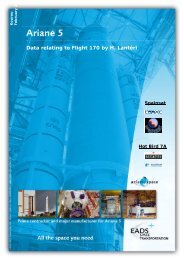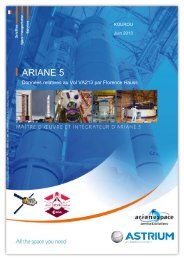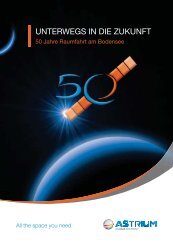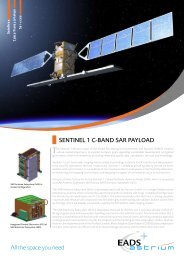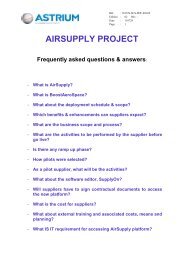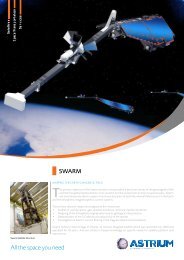Flight 207: Ariane 5 ECA/Echostar-17 - Astrium - EADS
Flight 207: Ariane 5 ECA/Echostar-17 - Astrium - EADS
Flight 207: Ariane 5 ECA/Echostar-17 - Astrium - EADS
Create successful ePaper yourself
Turn your PDF publications into a flip-book with our unique Google optimized e-Paper software.
Data relating to <strong>Flight</strong> <strong>207</strong><br />
To produce maps and enable weather forecasts to be made, the Meteosat satellites are<br />
equipped with a radiometer called SEVIRI (Spinning Enhanced Visible and Infra Red Imager).<br />
This imaging instrument, designed and built by <strong>Astrium</strong>, “sees” climatic phenomena in the<br />
visible and infrared, over one third of the globe’s surface (MSG-3 will “see” a zone ranging<br />
approximately from the North Pole to the South Pole and from Chile to India). This is the<br />
tenth radiometer of the Meteosat constellation, the first examples of which operated for up to 19<br />
years in space. Since the first model entered service, SEVIRI has been the world’s benchmark<br />
instrument for the design of the next generation of radiometers. It is the most efficient meteorological<br />
instrument in orbit.<br />
SEVIRI offers some major technological advances over<br />
the first generation Meteosat radiometers. It is capable<br />
of detecting 12 spectral bands instead of three, providing<br />
even more detailed observations. It offers a level of<br />
resolution three times greater than that of the previous<br />
radiometers (up to one kilometre), allowing on-demand<br />
close-ups of local climatic phenomena. Finally, SEVIRI<br />
is capable of scanning the surface of the Earth in just<br />
15 minutes, as opposed to 30 minutes for the previous<br />
generation.<br />
<strong>EADS</strong> <strong>Astrium</strong> produced the image processing system (IMPF) which provides the link between<br />
the SEVIRI instrument and the end-user. This required development, testing and installation of<br />
this software on the Eumetsat ground station in Darmstadt, Germany. Moreover, <strong>EADS</strong> <strong>Astrium</strong><br />
is responsible for training the Eumetsat engineers and will handle maintenance of the<br />
software for two years following delivery.<br />
23




